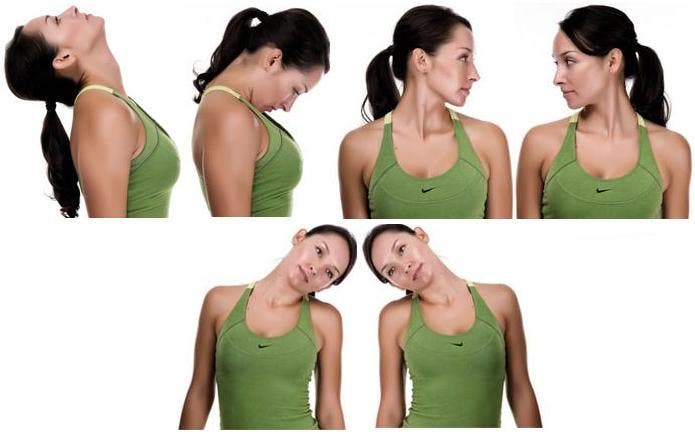Neck work should be part of anyone’s training routine, whether they are an athlete or not. It is boring, we agree, but with 5-10 minutes a couple of days a week, we will have already given it a good boost.
Vital in contact sports, hockey or rugby, you can see the size of the necks of some American football players. And it is that even doing a specific job of the same, there are not few neck injuries produced in tackles of these men that reach a brutal amount of movement.

In contact sports, a strong neck is essential, not only to increase the chances of victory, but it also reduces the chances of injury .
For example, we need to strengthen the eccentric neck flexion to absorb the neck extension forces that occur in a direct to the face. If the punch comes from the side, what we need is eccentric lateral flexion (lean) force . To support a knee in a muay thai clinch, eccentric extension force . In a hook to the jaw, eccentric rotational force.
As we can see in this type of sporting gestures, most of the muscular contractions where the neck is strongly stressed are eccentric in nature.
Neck movements
To understand how it works, first we are going to analyze the movements that the neck can perform and which muscles participate in them.
These are 4: flexion, extension, tilt or lateral flexion, and rotation. In the photo, from left to right, extension, flexion, left rotation, right rotation, left lateral tilt or flexion, and right tilt.

Flexion refers to the action of bending the head downward, moving the jaw toward the sternum. The muscles involved in this movement are the head and neck flexors (longus capitis, longus colli), and the anterior rectus of the head. It is a deep musculature, which is located in front of the spine.
The extension , where we move the head back, moving the jaw away from the sternum. The muscles responsible for this movement are the splenium, semispinatus, trapezius, and the suboccipital muscles. Basically the muscles of the neck. The suboccipital muscles are what make a cat always fall on its legs, due to the amount of stretch receptors that these muscles present. These muscles are tense and shortened, causing neck pain due to imbalances with the flexor muscles of the neck.
In lateral inclination or flexion , we tilt the head to one side, bringing the ear closer to the shoulder on the same side, being the scalenes and the sternocleidomastoid, the main muscles in charge of performing this action.
Rotation refers to the action of turning the head from one side to the other. The main muscles involved in this action are the splenium, sternocleidomastoid, levator scapulae, and the suboccipital muscles.
A study by Vasavada et al. (1) shows us that the neck is stronger in extension , then in inclination or lateral flexion, flexion and finally there is the rotational movement of the neck, the less strong movement of the neck. The following Torque values (measured in Nm) evaluate isometric force in men and women.
Neck action
- Extension 52/21 (Torque men / torque women)
- Lateral flexion 36/16
- Flexion 30/15
- Rotation 15/6
As can be seen, women have much less force in the neck, approximately half, although there are other studies where the differences recorded are smaller.
Neck training is effective, and proof of this is the study by Maeda et al. (2) in which 18 men underwent 8 weeks of training of 3 sets x 10 eccentric or concentric repetitions after which an improvement in isometric neck strength is shown (38% in the concentric group and 40% in the eccentric group ) and an increase in neck circumference (4.9% in the concentric group and 5.5% in the eccentric group).
Another study examined 50 men and 28 women over a period of 12 weeks, Pollock et to the. (3) found that isometric extension strength neck increased, along with dynamic collar work, or with dynamic work and isometric . It also concludes that neck training 2 days a week is more effective than 1 day. This study showed that a single set is sufficient to strengthen the neck. The subjects had their isometric strength in neck extension increased between 18 and 33%.
Bret Contreras cites the case of an elderly client, whose neck was fatigued, simply performing thoracic extensions on a foam roller (where the head is not supported by the foam cylinder) or even when doing an iron. This lady had difficulty performing a neck flexion or extension. After a month, the woman regained her isometric and dynamic neck strength, after performing a single series of neck flexion daily (we assume 10 repetitions) from a supine position on a foam roller and a single series of neck extension from an initial quadripod position.
All of these studies show us that specific neck work works, and strength gains are relatively quick.
Now, the next step is to select the different exercises to perform. The first thing is to make sure that the postural muscles of the neck are activated and working in a balanced way to maintain a correct posture of the head.
In the event that you have never worked on your neck, and also have neck or headaches, it is likely that you have weakened deep cervical flexor muscles , which, as we have mentioned before, are the muscles that are responsible for maintaining correct head alignment. and neck, and prevent the head from falling forward. The deep flexors (along with the scalene and sternocleidomastoid) are what truly protect the neck, and resist any pull / push allowing correct positioning.
If we add to that the fact that the sternocleidomastoid, trapezius or scalenes are over-activated, since we already have the muscular imbalance that may be responsible for pain in the neck and / or head. Therefore, this is the initial step, or level zero, in the progression when looking for a strong neck.
Level 0: deep cervical flexor work
To activate the deep cervical flexor muscles we have the craniocervical flexion exercise.
Lying face down, with the neck resting on a towel to maintain correct head alignment, we bring the neck towards the neck in a gesture similar to that of affirming with the head, as if wanting to remove the double chin, and initially hold for 10 seconds in this position . The goal is to reach 1 minute sets while holding the contraction. The volume of work would be 3 series , and the frequency, daily . After 1 month of regular practice, we will have managed to activate the deep flexors. This exercise can also be done sitting, or in quadripods.
Level 1: Isometrics
Now, the next step would be to work with isometric exercises. For this we will use our hands as resistance to overcome by the muscles of our neck. We will strengthen the stabilizing neck muscles again. There are people who prefer to do them lying on the ground, others standing, and others sitting. But the mechanics of the exercise are the same. We place our hands with the palms on the forehead, on the temple or on the nape, according to the movement of the neck that we want to work. We apply pressure for 5-10 ” with the head on the palms of the hand. Begin by applying light pressure, and as you gain strength, increase that pressure. Once you master the exercise, you can perform these exercises with a fitball, placing it between your head and the wall. 1 or 2 sets of 10 repetitions daily is enough to progress.
Level 2: Isotonic without load
Once we master the isometrics, we can move on to the isotonic resistance version with fitball (it can also be done with the help of the hands), in which we allow the head to move smoothly back and forth rolling on the ball. We can also perform head tilts and rotations. 1-2 sets of 10 reps for each type of neck movement. All smooth and controlled movements so as not to injure the neck. For example, damaging the sternocleidomastoid muscle can cause constant dizziness and severe cervibrachialgias. Of course, all exercises accompanied by their corresponding warm-up , and final neck stretching exercises to promote proper neck recovery after strength work. It is also important to stretch the pectoral musculature, because if it is contracted, it generates a too pronounced curvature of the thoracic spine backwards, which exaggerates the curvature of the cervical spine forward.
In the first minute of the video, the isometric version with fitball appears, and from minute 3 the isotonic exercises with fitball begin.
In the next installment we will move on to advanced exercises, which are recommended after 3 months of initial neck training with the exercises indicated in this article.
Sources:
- Solve your cervical problems , Heike Hofler
- Neck training 101 , Bret Contreras
(1) Three-dimensional isometric strength of neck muscles in humans , Vasavada et al.
(2) Effect of training on the strength of cervical muscle , Maeda et al.
(3) Frequency and volume of resistance training effect on cervical extension strength , Pollock et al.